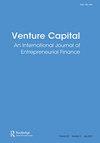A framework to assess the valuation techniques for new technology-based firms: a case in an emerging market
IF 2.3
4区 管理学
Q2 BUSINESS, FINANCE
引用次数: 1
Abstract
ABSTRACT Valuation of new technology-based firms and startups is one of the main concerns of these Firms. The need to expand financial resources and evaluate the potential income of these firms increases the importance of the valuation of these firms for entrepreneurs and investors. In this paper, we represent a comprehensive framework to assess the strengths and the weaknesses of the valuation methods in NTBFs with a focus on the factors in the emerging markets. For this purpose, different valuation methods and their related criteria for NTBFs are extracted and evaluated by experts in terms of applicability and Sufficiency. We categorized the existing valuation methods to 4 different groups: “asset valuation methods”, “intellectual property valuation methods”, “technology valuation methods”, and “startups valuation methods”. Then, the importance of each criterion is determined using the analytical hierarchical process method. Finally, we used fuzzy TOPSIS to prioritize each category of valuation methods and identify their strengths and weaknesses. The results indicate which sets of valuation methods are the more preferred method for Iranian entrepreneurs and investors to evaluate different kinds of NTBFs. Besides, the results of the model on different criteria proposed different suggestions to improve the existing valuation methods.评估新技术公司估值技术的框架:一个新兴市场的案例
新技术公司和初创公司的估值是这些公司主要关注的问题之一。由于需要扩大财政资源和评估这些公司的潜在收入,因此对企业家和投资者来说,对这些公司进行估值就更加重要了。在本文中,我们代表了一个全面的框架来评估非结构性投资基金估值方法的优势和劣势,重点关注新兴市场的因素。为此,专家从适用性和充分性两个方面对ntbf的不同评价方法及其相关标准进行了提炼和评价。我们将现有的估值方法分为4类:“资产估值方法”、“知识产权估值方法”、“技术估值方法”和“创业公司估值方法”。然后,采用层次分析法确定各指标的重要性。最后,我们使用模糊TOPSIS对每一类评价方法进行优先排序,并确定其优缺点。结果表明,伊朗企业家和投资者在评估不同类型的非营利性投资基金时更倾向于采用哪一套评估方法。此外,模型的结果对不同的标准提出了不同的建议,以改进现有的评估方法。
本文章由计算机程序翻译,如有差异,请以英文原文为准。
求助全文
约1分钟内获得全文
求助全文
来源期刊

Venture Capital
BUSINESS, FINANCE-
CiteScore
4.10
自引率
16.70%
发文量
21
期刊介绍:
Venture Capital publishes cutting edge research-based papers from academics and practitioners on all aspects of private equity finance such as: •institutional venture capital •informal venture capital •corporate venture capital •public sector venture capital •community venture capital It also covers all aspects of the venture capital process from investment decision to exit, including studies on: •investment patterns •investment decision-making •investment performance •realisation of investment value exit routes (including the relationship with junior capital markets such as NASDAQ, EASDAQ, AIM and Nouvelle March). •economic impact and public policy
 求助内容:
求助内容: 应助结果提醒方式:
应助结果提醒方式:


